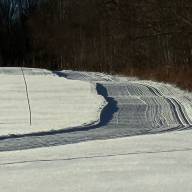Who knows that human urine contains vital nutrients for growing crops? On Thursday, October 19, Joslin Memorial Library in Waitsfield hosted a presentation about collecting and recycling urine as a resource for sustainable farms, gardens, and water systems.
Julia Cavicchi, education director of the Rich Earth Institute in Vermont, presented “Peecycling for Clean Water and Fertile Farms.” She said that human urine can not only be used as a local source of fertilizer for crops, but collecting it can conserve clean water and prevent downstream pollution.
The Brattleboro-based Rich Earth Institute operates the first and largest community-scale urine recycling program in the U.S., collecting 12,000 gallons of urine annually, according to their website. It was founded in 2012.
The institute’s employees collect urine from a center where community members can drop it off, or directly from peoples’ homes, using trucks to siphon it from tanks that people typically store in their basements. From there, the urine is transported to a processing center that sanitizes it for permitted use on farm land. In total, the institute has partnered with nine farms in Brattleboro and surrounding areas, who use the urine as fertilizer.
In her presentation, Cavicchi outlined the myriad reasons for choosing to recycle urine rather than routing it through septic systems and wastewater treatment plants, which do not make use of its nutrients. She said while most fertilizer is imported from a long distance and require fossil fuels for transport, local urine is a sustainable source of fertilizer for peoples’ home gardens and agricultural land. The use of local urine is especially important, she said, in the context of global fertilizer shortages due to the war in Ukraine.
Additionally, Cavicchi said that while wastewater treatment plants and septic systems were designed to control the spread of pathogens, neither are very good at removing nutrients, hormones, microplastics, and other contaminants – ultimately releasing them back into the environment.
For example, Cavicchi said that phosphorus in urine, once in waterways, can act as a fertilizer for algae blooms, as in Lake Champlain. Pharmaceutically active compounds are also an issue, as they travel through septic systems and wastewater treatment plants largely unchanged, she said.
“Pharmaceuticals have lives of their own once our bodies are done with them,” the Rich Earth Institute writes on its website – ultimately flowing into downstream bodies of water. Researchers at the institute say that pharmaceuticals have various disruptive effects on aquatic species and can enter communities’ drinking water sources, with largely unknown effects.
For six years, the institute partnered with the University of Michigan and others to study the presence of 26 different pharmaceuticals and hormones in soil, groundwater and crop tissues after urine was applied as fertilizer. They found that no traces of hormones remained, and while there were some pharmaceuticals still detectable in crop tissue, the levels were extremely small.
Cavicchi said that ‘peecycling’ has been utilized since the advent of agriculture and that the past few decades have seen an interest in the large-scale, technological side of it. The Swiss Institute of Aquatic Science and Technology, founded in 1936, was one research center that ignited academic interest in the field of urine diversion.
Joslin library program coordinator Shevonne Travers said that she became interested in hosting the presentation after hearing a segment about human composting on public radio one day. “And after hearing that there are urine collection stations in two towns in southern Vermont, I thought that perhaps, the Mad River Valley might wish to pursue this idea.”
“Unfortunately, in order to move this idea forward in The Valley,” Travers said, “there will need to be more enthusiasm for doing so, and a much larger partnership.”
Cavicchi said that people across Vermont, especially those who already use composting toilets, have been “quite receptive and interested.” In order to implement a community-scale program locally, she said that an organizing entity is needed – whether a town, farm or nonprofit organization. “Someone needs to coordinate the movement of urine from collection sites, to a treatment facility, to farms. It takes some amount of commitment and staff time,” she said, adding that the Rich Earth Institute is looking for community partners to apply for a grant through the Lake Champlain Watershed, which could fund that work.
At Thursday’s presentation, participants took a portable urine collector home – a five-gallon container with a funnel and water-tight fittings. It came with a spout for easy transfer to a watering can for home-garden use and a guidebook. Others who are interested in getting a free kit in the future can contact the institute.
Cavicchi said that she became interested in urine recycling several years ago. “I was interested in the ways that wastewater infrastructure is not prepared to face the challenges of climate change. And in alternative models for managing our waste, turning it into something beneficial instead of a source of harm.”













